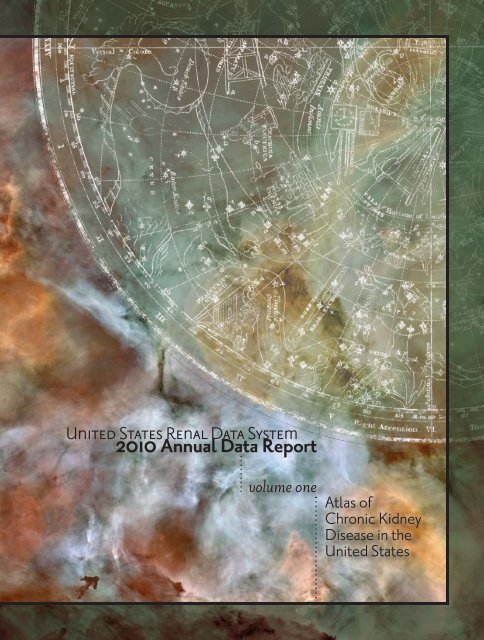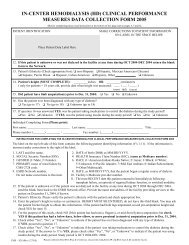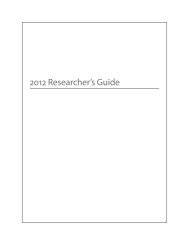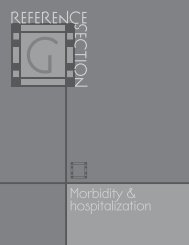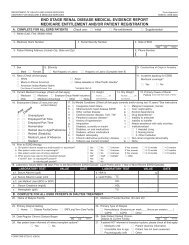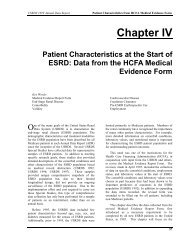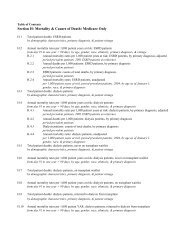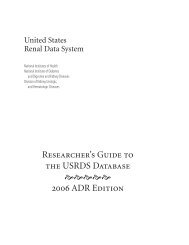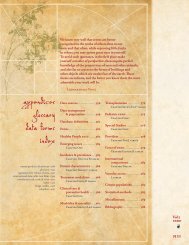(2010) USRDS 2010 - United States Renal Data System
(2010) USRDS 2010 - United States Renal Data System
(2010) USRDS 2010 - United States Renal Data System
Create successful ePaper yourself
Turn your PDF publications into a flip-book with our unique Google optimized e-Paper software.
�������������������������������<br />
�����������������������<br />
���������� ����������<br />
���������������<br />
����������������<br />
�������������
Tables of contents listing all chapters<br />
in the ckd & esrd volumes, the main<br />
topics covered within them, & the<br />
reference sections & appendices;<br />
pages 7–9 of Volume One & pages<br />
195–197 of Volume Two.<br />
Chapter tables of contents<br />
listings of all two-page<br />
spreads; found on the<br />
third page of each<br />
chapter.<br />
Information map<br />
listings of central<br />
topics in the adr;<br />
pages 10–11 of Volume<br />
One & pages 200–201<br />
of Volume Two.<br />
CD-ROM both volumes<br />
of the adr, slides of<br />
������������������������<br />
of all data, &����������<br />
��������������������������<br />
with the adr.<br />
Reference tables<br />
ckd: pages 145–162 of<br />
Volume One; esrd:<br />
pages 397–460 of<br />
Volume Two.<br />
��ndin�����������n����<br />
in������nn���������������<br />
Glossary with a list of acronyms;<br />
page 180 of Volume One &<br />
page 500 of Volume<br />
Two.<br />
Chapter summaries<br />
central points from<br />
each two-page<br />
spread; found on<br />
the last page of each<br />
chapter.<br />
Index to the ckd<br />
& esrd volumes;<br />
page 185 of Volume<br />
One & page 521 of<br />
Volume Two.
united states renal data system<br />
<strong>2010</strong><br />
usrds<br />
data<br />
annual<br />
report<br />
volume<br />
���<br />
atlas of chronic kidney<br />
disease in the united states<br />
n����n����n������������������<br />
n����n����n�������������������������������������n�����������<br />
�������n�������n������������������m�����������������
<strong>2010</strong><br />
usrds<br />
annual<br />
data<br />
report<br />
volume<br />
���<br />
ckd<br />
page 4<br />
Production of this Annual <strong>Data</strong> Report (adr) was solely funded through nih contract hhsn 267 2007 15002c / no1-dk-7-5002 with the Minneapolis<br />
Medical Research Foundation (mmrf). Most contributors to this report are employed by mmrf, with many of the physician investigators<br />
being employed by mmrf’s parent organization, Hennepin Faculty Associates. mmrf�����������������������������������coi) policies<br />
and practices governing the conduct of research within the usrds and of other research not related to the usrds. In addition to internal<br />
controls, usrds work is overseen by niddk�����������������������usrds Steering Committee, and the usrds External Advisory Committee.<br />
Listed here are those who contributed to the 2009 adr. Unless otherwise noted in parentheses, the contributor’s employer was mmrf or<br />
its parent organization, Hennepin Faculty Associates.<br />
���������������������������� Allan Collins, md, facp, usrds Director (entire adr). Robert Foley, mb, msc, usrds Deputy<br />
Director (entire adr). Blanche Chavers, md (University of Minnesota School of Medicine; Vol 2, Ch 8). David Gilbertson, phd (entire<br />
adr). Charles Herzog, md (Vol 1, Ch 5; Vol 2, Ch 9). Areef Ishani, md, ms (Vol 1, Ch 8). Kirsten Johansen, md (University of California<br />
at San Francisco; Vol 2, Ch 9). Bertram Kasiske, md (Vol 2, Ch 7). Nancy Kutner, phd (Emory University; Vol 2, Ch 9). Suying<br />
Li, phd (Vol 1, Ch 4; Vol 2, Précis & Chs 1, 6, 8; H & I tables). Jiannong Liu, phd (maps; Vol 2, Ch 10; E tables). Lih-Wen Mau, phd<br />
(Vol 1, Ch 9; Vol 2, Ch 12). Anne Murray, md, msc (Vol 1, Ch 6). Wendy St. Peter, PharmD, bcps (Vol 1, Chs 3 & 7; Vol 2, hp<strong>2010</strong><br />
& Chs 1, 5, & 11). Jon Snyder, phd (Vol 2, Ch 7). ������� administrative staff Beth Forrest, bba (Vol 2, Ch 12). ADR production<br />
Edward Constantini, ma (entire adr). Susan Everson, phd (entire adr). biostatisticians Haifeng Guo, ms (Vol 1, Ch 3;<br />
Vol 2, hp<strong>2010</strong> & Chs 5, 8, 10). Sally Gustafson, ms (Vol 2, Ch 7; e & f tables). Shuling Li, ms (Vol 1 , Ch 6; Vol 2, hp<strong>2010</strong><br />
& Ch 9). Yi Peng, ms (Vol 1, Chs 1 & 2; Vol 2, Précis & Ch 6). Yang Qiu, ms (Vol 1, Ch 8). Tricia Roberts, ms (Vol 1,<br />
Ch 4; Vol 2, Précis & Chs 1, 6, 8; g tables). Melissa Skeans, ms (Vol 2, Précis, hp<strong>2010</strong>, Chs 3 & 7; e & f tables).<br />
Craig Solid, ms (entire adr). Changchun Wang, ms (Vol 1, Précis & Chs 1, 2, 3, & 7; Vol 2, hp<strong>2010</strong> & Ch<br />
10). Eric Weinhandl, ms (Vol 1, Ch 5; Vol 2, Chs 5, 9, 10). David Zaun, ms (Vol 1, Ch 7; Vol 2, Chs<br />
3, 5, 10). information systems & software development for all chapters, with additional work as<br />
noted: Cheryl Arko, ba. Shu-Cheng Chen, ms (Vol 2, Précis; Chs 4 & 8; d tables). Frederick<br />
Dalleska, ms (Vol 2, Précis, Ch 10; i tables). Frank Daniels, bs. James Ebben,<br />
bs (Vol 1, Ch 9; Vol 2, Précis & Ch 11; k tables). Eric Frazier, bs (Vol 2, Précis,<br />
hp<strong>2010</strong>, Chs 1, 2, 3, 4, 8; a, b, c, m tables). Christopher Hanzlik, bs.<br />
Roger Johnson. C Daniel Sheets, bs. Xinyue Wang, ba/bs.<br />
disclosures for potential confl icts of interest<br />
funding & chapter contributors<br />
Allan Collins, MD, FACP Consultant/honoraria:<br />
Amgen, Baxter, NxStage, Sigma-<br />
Tau, Takeda. Robert Foley, MB, MSc Consultant/honoraria:<br />
21st Services, Amgen, Luitpold, Medscape, Merck, Novartis, Ortho,<br />
Vifor Pharma. David Gilbertson, PhD Consultant/honoraria: Amgen, DaVita<br />
Clinical Services. Charles Herzog, MD Consultant/honoraria: Amgen, CorMedix,<br />
������������������������������������������������������������������������������������<br />
Cambridge Heart, Merck. Bertram Kasiske, MD Consultant/honoraria: Litholink. Kirsten Johansen,<br />
MD Consultant/honoraria: Amgen. Research support (non-salary): Abbott, Amgen. Anne<br />
Murray, MD, MSc Equity ownership: Medtronic. Jon Snyder, PhD Consultant/Honoraria: Genzyme<br />
Transplant. Also, mmrf as an institution has separate contracts to conduct other, independent research funded<br />
by 21st Services, amag Pharmaceuticals, Amgen, Baxter, Bristol-Myers Squibb, DaVita, Fresenius, the Centers for<br />
Disease Control and Prevention, Genzyme, Merck/Schering-Plough, Mitsubishi Tanabe Pharma America, the National<br />
Institute on Aging / National Institutes of Health, the National Kidney Foundation, NxStage, Ortho-McNeil-Janssen,<br />
Satellite Healthcare, Shire, Sigma-Tau, and Takeda.<br />
This 22nd annual report of the <strong>United</strong> <strong>States</strong> <strong>Renal</strong> <strong>Data</strong> <strong>System</strong> is produced by the usrds Coordinating Center, operated<br />
under nih contract hhsn 267 2007 15002c / no1-dk-7-5002 by the Minneapolis Medical Research Foundation.<br />
������������������������������������u.s. <strong>Renal</strong> <strong>Data</strong> <strong>System</strong>, usrds <strong>2010</strong> Annual <strong>Data</strong> Report: Atlas of Chronic Kidney Disease<br />
and End-Stage <strong>Renal</strong> Disease in the <strong>United</strong> <strong>States</strong>, National Institutes of Health, National Institute of Diabetes and Digestive and<br />
Kidney Diseases, Bethesda, md, <strong>2010</strong>. ���������������������������������������������������������������������������������<br />
�������������������������������������� The data reported here have been supplied by the <strong>United</strong> <strong>States</strong> <strong>Renal</strong> <strong>Data</strong> <strong>System</strong> (usrds).<br />
���������������������������������������������������������������������������������������������������������������������������������������������������<br />
pretation of the U.S. government. �� ��������������� In titles, the superscript number or letter refers to the chapter, the following number<br />
�������������������������������������������������������������������������������������������������������������������������������������������������<br />
volume by periods — i.e., 3.1.ii refers to Chapter Three, Figure 1, Volume Two.
Upon the mountain’s edge with light touch resting,<br />
There a brief while the globe of splendour sits<br />
And seems a creature of the earth, but soon,<br />
More changeful than the Moon,<br />
To wane fantastic his great orb submits,<br />
Or cone or mow o����������������������owly<br />
Even to a star at length he lessons wholly.<br />
Samuel Taylor Coleridge<br />
“A Sunset”<br />
page<br />
5
<strong>2010</strong><br />
usrds<br />
annual<br />
data<br />
report<br />
volume<br />
���<br />
ckd<br />
page 6<br />
at www.usrds.org<br />
pdf�������������<strong>2010</strong> adr�����������&���������������������������������������������������<br />
adr��gures &���������&����������������������������g����������������������������������������-<br />
������������� render�������������������������������������������g usrds��������������������-<br />
�����������������������g���������������usrds ��������g��������������adr��gures &��������<br />
new to this edition of the annual data report<br />
������������������������������������������������������������������������������esrd����������g������<br />
������������������g������������������g������������������������������&���������������������������������-<br />
�������������g�����������������ckd & esrd�������������������g��g���������������������������������������<br />
�����������������������������������������������������������������������g�����������������������������������������<br />
�������������������bmi &�����������������������������g����������������������g��������������������������������������<br />
������������������esrd����������&���������������������������������������������������������������������u.s. &��������<br />
�������������������������������esrd����������&�����g�����������������
Volume<br />
One CKD<br />
��������������� 8<br />
in���������n����<br />
����m���n� 12<br />
��������������������������ckd<br />
�������������������� 17<br />
1 ckd����������������<br />
���������� 39<br />
2 ckd������������������<br />
����������� 53<br />
3 ����������������������ckd 65<br />
4 ����������&���������� 77<br />
5 ��������������������������<br />
��������������ckd 87<br />
6 ���������������������������<br />
���������������������<br />
��������������ckd 99<br />
7 ������������������esrd 109<br />
8 ������������������� 121<br />
9 ���������ckd 133<br />
���������������� 145<br />
����������<br />
������������������������������� 1644<br />
����������<br />
usrds ���������&��������� 174<br />
�������� 180<br />
����� 185<br />
������������� 174<br />
������������������men� 183<br />
Volume<br />
Two ESRD<br />
���������������� 196<br />
in���m����n�m��� 198<br />
������m���mm����&��������������� 200<br />
in���������n��������m������ 202<br />
��������������������������esrd<br />
��������������������� 209<br />
����������������������<strong>2010</strong> 223<br />
1�� ���������������� 239<br />
2�� ����������&������������ 253<br />
3�� ������������������������ 267<br />
4�� ��������������������� 277<br />
5�� ��������������������&������������������� 287<br />
6�� ����������&����������� 301<br />
7�� ��������������� 311<br />
8�� ����������esrd 325<br />
9�� ���������������� 335<br />
10������������ 353<br />
11�� ���������esrd 367<br />
12���������������������������� 383<br />
����������������� 397<br />
������������������������������������������� 462<br />
���������� usrds����������&���������� 494<br />
��������� 500<br />
cms������� 507<br />
������ 521<br />
�������������� 524<br />
��������� 526<br />
�������������� 494<br />
������������������men�� 503<br />
in���n����n�����������������n����m� 505<br />
page<br />
7
<strong>2010</strong><br />
usrds<br />
annual<br />
data<br />
report<br />
volume<br />
���<br />
ckd<br />
page 8<br />
Volume<br />
One CKD<br />
����������������������������������������������������������������������� 17<br />
summary statistics; awareness, treatment, & control; patient characteristics; prescription drug<br />
therapy; hospitalization & mortality; cardiovascular disease; the transition zone in nursing<br />
home patients; the transition to ESRD; acute kidney injury; costs of CKD<br />
������������������������������������������������������ 39<br />
strategies for identifying CKD; comorbidity burden; clinical & biochemical abnormalities;<br />
awareness, treatment, & control of disease conditions; predictive models for CKD; mortality<br />
��������������������������������������������������������� 53<br />
incidence & prevalence of recognized CKD; CKD as defined by the new diagnosis codes;<br />
comorbidity burden in patients with CKD; describing CKD through laboratory values<br />
���������������������������������������������������� 65<br />
identified CKD & physician follow-up; laboratory evaluations; prescription drug therapy;<br />
biochemical levels & drug therapy<br />
Volume<br />
Two ESRD<br />
������������������������������������������������������������������������ 209<br />
trends in patient counts & spending; modalities; quality of care; hospitalization & mortality;<br />
expenditures<br />
������������������� � 223<br />
incident rates; cardiovascular disease; counseling prior to ESRD; fistula use; transplantation;<br />
diabetes; care of patients with CKD & diabetes; urine microalbumin measurements;<br />
vaccinations; network achievement of HP<strong>2010</strong> objectives<br />
�������������������������������������������������������� 239<br />
all-cause & cause-specific hospital admissions; hospitalizations for vascular access infection;<br />
outpatient antibiotic use; infectious hospitalization & antibiotic use; mortality & antibiotic use<br />
��������������&������������� 253<br />
incidence; prevalence; incident rates & racial differences; rare diseases; network populations<br />
������������������������������ 267<br />
patient care prior to initiation; anemia & treatment; laboratory values at initiation; transplant<br />
options; wait list & transplantation<br />
��������������������������� 277<br />
incident modality; prevalent modality; home hemodialysis; introduction to Part D<br />
������������������������&�������������������� 287<br />
anemia treatment & hemoglobin control; preventive care; vascular access in prevalent patients;<br />
overview of Medicare Part D use
���������������&������������ 77<br />
hospitalization rates in CKD & non-CKD patients; infectious hospitalizations; mortality rates<br />
�������������������������������������������������������������������� 87<br />
prescription drug therapy; survival & hospitalization; prevalent disease states;<br />
treatment for heart disease<br />
������������������������������������������������������������������ckd � 99<br />
cognitive function; physical function; mortality<br />
������������������������������������������������� 109<br />
patient care & laboratory testing prior to ESRD; prescription drug therapy & medication<br />
continuity in the transition to ESRD<br />
��������������������������� 121<br />
characteristics of patients with AKI; overall hazard & adjusted rates of AKI; patient care &<br />
outcomes following AKI hospitalization<br />
�������������������������������������� 133<br />
overall costs; components of costs; Medicare Part D costs; CKD costs in the U.S. & Taiwan<br />
��������������������� � 145<br />
��������������&������������ 301<br />
overall hospitalization; outcomes; hemodialysis matched to peritoneal dialysis;<br />
cause-specific hospitalization & mortality<br />
����������������������� 311<br />
kidney transplant wait list; kidney donation & transplantation; transplant discharge<br />
& follow-up; transplant outcomes; transfusions & panel-reactive antibodies<br />
����������������������������������������� 325<br />
patient counts; preventive care & hospitalization; first-year hospitalization & mortality<br />
���������������������� 335<br />
cardiovascular special studies; rehabilitation & quality of life special studies;<br />
nutrition special studies<br />
��������������� 353<br />
provider growth; anemia treatment; clinical monitoring; preventive care;<br />
costs for interventions & preventive care; vascular access & fluid overload<br />
hospitalizations; standardized hospitalization & mortality ratios<br />
����������������������������������������� 367<br />
overall costs of ESRD; costs overall & for injectables & vascular access; racial differences<br />
in costs; costs in matched & unmatched dialysis populations; Medicare Part D costs<br />
���������������������������������� 383<br />
incidence & prevalence of ESRD; dialysis; transplantation;<br />
incident ESRD rates in Asian & indigenous populations<br />
���������������������� � 397<br />
page<br />
9
<strong>2010</strong><br />
usrds<br />
annual<br />
data<br />
report<br />
volume<br />
��� ckd<br />
page<br />
��<br />
�����i�� CKD �vol 1�� C�a�ter 6<br />
P������i��s NHANES CKD �vol 1�� C�a�ter 1 new patients CKD �vol 1�� 2.2, 2.4–6, 2.10–13; ESRD<br />
CKD �vol 1�� 9.18–23; ESRD �vol 2�� C�a�ter 12 C�g�i�i�e�<br />
�vol 1� 2.a pediatric patients ESRD �vol 2�� C�a�ter 8 international comparisons;<br />
2.7–9, 2.14–17; ESRD �vol 2�� �.1–3, �.7, C�a�ter 2, 4.2, 4.b–8, 8.1, 8.5–7 CKD datasets<br />
�vol 2�� �.a–4, �.7, ��.2, C�a�ter 2, 4.1, 4.a–5, 8.1–4 existing patients CKD �vol 1�� C�a�ter 1, 2.3,<br />
& E S<br />
THE�<strong>2010</strong>�ANNUAL�DATA�REPORT�<br />
A E S I D Y E N D I K C I N O<br />
IN�<br />
R<br />
ON�<br />
H C<br />
I AT<br />
F O<br />
M R<br />
S<br />
O<br />
A<br />
F<br />
L<br />
N I<br />
T A<br />
T�e���e��� preventive care ESRD �vol 2��<br />
antibiotics ESRD �vol 2�� 1.15–21, 1.25–33 awareness/treatment/control<br />
��.21–� 5.10–16, 8.8–9, 10.13–18 drug therapy CKD<br />
�vol 1�� 3.27–24, 5.a–5, 5.13–19, 7.13–a ESRD �vol2�� 5.24–40<br />
C�a�ters 4 & 7 laboratory values & testing CKD �vol 1�� 1.�–9, 2.c–26, 3.9–16, 7.7–12; ESRD �vol 2�� 3.b–13<br />
�vol 2�� 5.1 dialysis access ESRD �vol 2�� 3.1, 3.2–4, 5.17–23 transplantation �vol 2� �.6, ��.14–17,<br />
physician care CKD �vol 1�� 3.2–8, 7.2–6; ESRD �vol 2�� 3.2–a KDOQI guidelines ESRD<br />
CKD �vol 1�� 1.e–13, 3.25–28 anemia treatment ESRD �vol 2�� 3.5–7, 5.2–9
PA � F O � S RTI<br />
C I P O<br />
R E G A T S -<br />
T<br />
E<br />
D<br />
N<br />
N<br />
A<br />
E<br />
CULAR�<br />
L I D<br />
INTEREST<br />
SEA SE IN THE U. S.<br />
Dise�ses identifying CKD �vol 1�� 1.a–4, 2.10–17 anemia ESRD �vol 2�� 3.5–7, 5.2–9 cardiovascular disease<br />
CKD �vol 1�� 1.c–8, 3.15, C�a�ter 5; ESRD �vol 2�� ��.5, 6.15, 9.2–14 diabetes CKD �vol 1��<br />
C�a�ter 1, 2.12.b–18; ESRD �vol 2�� ��.18–21, 2.7, 2.15, 5.10–13, 6.7, 10.13–15 acute kidney<br />
injury �vol 1� C�a�ter 8 Medi���e�P����D CKD �vol 1�� 9.12–17; ESRD �vol 2��<br />
4.12–e, 5.24–40, 11.47–59 C�s�s CKD �vol 1�� C�a�ter 9; ESRD �vol 2��<br />
�.20–28, C�a�ter 11<br />
O�����es hospitalization<br />
CKD �vol 1��<br />
C�a�ter 4, 5.7–8; ESRD �vol 2�� �.16, 1.1–14, 1.22–24,<br />
C�a�ter 6, 8.10–15 mortality CKD �vol 1��, 1.18–21, 4.16–19;<br />
ESRD �vol 2�� �.17–18, C�a�ter 6, 8.16–18 survival CKD �vol 1�� 5.6;<br />
ESRD �vol 2�� �.19, 6.7, 8.19 D���������sis analytical methods �A��en��x A�<br />
CKD �vol 1�� �� 164; ESRD �vol 2�� �� 462 data � les available to researchers �A��en��x B�<br />
�� 174 �vol 1�, �� 494 �vol 2� agreement for release of data �� 183 �vol 1�, �� 503 �vol 2�<br />
page<br />
��
<strong>2010</strong><br />
usrds<br />
annual<br />
data<br />
report<br />
volume<br />
��� ckd<br />
page<br />
��<br />
disease (CKD), defining its burden in the general population, and looking<br />
a surveillance<br />
system coordinated<br />
by the National<br />
Center for Health Statistics at<br />
at cardiovascular and other comorbidities, adverse events, preventive the Centers for Disease Control and<br />
care, prescription medication therapy, care during the transition Prevention. The conceptual model of this<br />
to ESRD, and costs to Medicare and employer group health system was based on similar approaches for<br />
plans. In Volume Two we provide information on the size populations at risk for diabetes and hypertension,<br />
and impact of the end-stage renal disease (ESRD) popu- two well-known diseases that damage the kidney as<br />
lation — the traditional focus of the <strong>USRDS</strong> — pre- well as other organ systems. The model characterizes<br />
senting an overview of the ESRD program, along progressive stages of CKD, from early evidence of kidney<br />
with detailed data on incidence, prevalence, damage — such as albumin in the urine — to overt reductions<br />
comorbidity of new ESRD patients, severity in the filtering capacity of the kidney, defined by the estimated<br />
of disease, clinical care, hospitalization and glomerular filtration rate (eGFR).<br />
mortality rates, pediatric patients, renal There are many issues related to defining the levels of eGFR and<br />
transplantation, the provider delivery urine albumin which indicate “true disease” in the kidney during the<br />
system, and the economics of the early stages of CKD, as compared to a normal reduction in kidney fil-<br />
ESRD program.<br />
tering capacity, particularly in the elderly. A new estimating equation was<br />
We approach Volume One published in the Annals of Internal Medicine in May, 2009, improving on<br />
from the perspective that the the MDRD method; we compare these two equations, providing a perspective<br />
implications of CKD were un- for readers on the strengths and weaknesses of each. The <strong>USRDS</strong> and others will<br />
der-appreciated prior to Feb- continue to investigate these issues in both the clinical and public health arenas,<br />
ruary, 2002, when a new but already there is important data available on the impact of CKD, data based not<br />
CKD classification staging only on biochemical information, but on the disease as defined within the Medicare<br />
system was proposed. and health plan datasets. The impact of the CKD staging system as a predictor of mor-<br />
The five-stage system bidity and mortality is now well known on a population level, but its translation into<br />
was developed using the care of individual patients is another matter.<br />
population-level data The 2008 ADR was the first to include a volume dedicated to CKD; this year we expand<br />
from the National the volume to ten chapters, including an analysis of acute kidney injury as well as a chapter<br />
Health and Nutri- on cardiovascular disease. New this year is a chapter on the transition between CKD and<br />
tion Examination ESRD in nursing home patients, and analyses of medication use under the Part D prescrip-<br />
Survey (NHANES), tion drug benefit, which began in 2006.<br />
j ����������������������������������������������������������������<br />
�����������������������������������������������������������<br />
�����������������������������������������������������<br />
introduction to volume one � ckd
In the Précis we highlight some of the most<br />
important data from the chapters, and address<br />
the burden of CKD — an area of major public policy<br />
and health concern. In Chapter One we then define<br />
the CKD population, using NHANES cohorts over a 20year<br />
period, and looking at the burden of chronic conditions<br />
such as diabetes and cardiovascular disease. We also<br />
compare CKD populations identified through the MDRD<br />
and CKD-EPI equations, and address the degree of biochemical<br />
and clinical abnormalities. We conclude with analyses of<br />
awareness, treatment, and control of cardiovascular risk factors,<br />
and an assessment of mortality rates by eGFR, race, and gender.<br />
Basic descriptive and comorbidity information from the major<br />
datasets used by the <strong>USRDS</strong> — the 5 percent Medicare sample,<br />
and the MarketScan and Ingenix i3 databases — is summarized in<br />
Chapter Two. We use laboratory data from the Ingenix i3 LabRx dataset<br />
to define, by CKD stage, levels of typical biochemical parameters.<br />
Remarkably, the abnormalities identified here are quite similar to<br />
those in the NHANES population-level data. We also demonstrate the<br />
consistency of the relationship between CKD defined from actual laboratory<br />
data and that reported by diagnosis codes on claims for services.<br />
In Chapter Three we address the care of patients with CKD, looking<br />
at the likelihood of urine microalbumin testing based on diabetic and<br />
hypertensive status. Testing rates are surprisingly low, particularly<br />
among patients with hypertension — known for its associated risk of<br />
kidney disease. We then report on the use of prescription medications,<br />
including ACEIs/ARBs, beta blockers, calcium channel blockers, lipid<br />
lowering agents, diuretics, ESAs, oral Vitamin D, and phosphate binders,<br />
and examine the degree of lipid and glycemic control.<br />
Hospitalization and mortality across chronic disease conditions<br />
are examined in Chapter Four, along with hospitalizations for<br />
pneumonia, bacteremia/sepsis, and urinary tract infections, and<br />
trends in adjusted rates of mortality. Although increased recognition<br />
of kidney disease can bias the patient cohort over time,<br />
adjustments for severity of disease help reduce this bias, and<br />
demonstrate that survival has improved.<br />
Cardiovascular disease in the CKD population is the focus<br />
of Chapter Five, in which we evaluate, by CKD stage, major<br />
cardiovascular diagnoses and interventions, medication<br />
use, survival, and hospitalization.<br />
Chapter Six addresses the transition to ESRD in the<br />
institutionalized elderly entering nursing homes,<br />
using data from the Medicare Minimum <strong>Data</strong> Set.<br />
We first compare general nursing home patients<br />
to those with CKD and ESRD, then examine how<br />
memory, decision making, and the ability to make oneself<br />
understood change over time after admission to a<br />
nursing home. We also look at physical function in the<br />
non-CKD, CKD, and ESRD populations, and conclude<br />
with analyses of survival.<br />
Chapter Seven addresses the transition from<br />
CKD to ESRD, a period of great concern, and one<br />
which may contribute to high mortality in the<br />
first months on dialysis. We illustrate the time-<br />
line for recognition of CKD prior to ESRD, and<br />
present data on visits to primary care physicians<br />
and to specialists among patients<br />
who reach ESRD, assessing when providers<br />
begin to recognize the trajectory of the<br />
disease in this vulnerable population.<br />
In Chapter Eight we continue our<br />
analysis of acute kidney injury (AKI)<br />
and its relationship to CKD and ESRD.<br />
Recognized AKI has been increasing<br />
in both the Medicare and the younger<br />
EGHP populations. We examine the<br />
type of dialysis used, if any, and the<br />
underlying diagnoses. We then look<br />
at follow-up after discharge, determining<br />
which physicians see these patients<br />
and what role nephrologists play<br />
in the first year after AKI. We have also<br />
added data on medication use and on<br />
rehospitalization for AKI.<br />
We conclude with Chapter Nine, addressing<br />
the costs associated with CKD,<br />
and introducing new analyses comparing<br />
costs in the U.S. and Taiwan. We also present<br />
data on prescription drug costs in 2007<br />
under the new Part D benefit.<br />
<strong>Data</strong> presented in this volume illustrate<br />
the challenges that CKD, its complications,<br />
and its costs pose to the healthcare system<br />
and to policy makers. Programs to detect CKD<br />
have been initiated by the CDC, and the National<br />
Kidney Foundation’s Kidney Early Evaluation<br />
Program (KEEP) has been ongoing since 2000. By<br />
their nature, detection programs are broad-based approaches<br />
to define, through the use of simple tests, populations<br />
at risk of a disease or its complications, targeting<br />
continued on page 16<br />
page<br />
��
<strong>2010</strong><br />
usrds<br />
annual<br />
data<br />
report<br />
volume<br />
��� ckd<br />
page<br />
��<br />
I ai<br />
I 1i<br />
<strong>USRDS</strong><br />
contacts<br />
Centers for<br />
Medicare &<br />
Medicaid Services<br />
External<br />
Advisory<br />
Committee<br />
Co-Project Offi cer, <strong>USRDS</strong><br />
Lawrence Y.C. Agodoa, MD<br />
NIDDK<br />
2 Democracy, Room 653<br />
6707 Democracy Blvd<br />
Bethesda, MD 20892-5454<br />
Phone 301.594.1932<br />
Fax 301.594.9358<br />
agodoal@extra.niddk.nih.gov<br />
Co-Project Offi cer, <strong>USRDS</strong><br />
Paul W. Eggers, PhD<br />
NIDDK<br />
2 Democracy, Room 615<br />
6707 Democracy Blvd<br />
Bethesda, MD 20892-5454<br />
Phone 301.594.8305<br />
Fax 301.480.3510<br />
eggersp@extra.niddk.nih.gov<br />
CC data requests<br />
612.347.7776 or<br />
1.888.99<strong>USRDS</strong>;<br />
usrds@usrds.org<br />
CC data fi les<br />
Shu-Cheng Chen, MS, MPH<br />
schen@usrds.org<br />
Website, RenDER<br />
Eric Frazier, BS<br />
Stephan Dunning, MGIS<br />
webmaster@usrds.org<br />
Administrative<br />
oversight of the <strong>USRDS</strong><br />
National Institutes<br />
of Health (NIH)<br />
National Institute of<br />
Diabetes & Digestive &<br />
Kidney Diseases (NIDDK)<br />
Division of Kidney,<br />
Urologic, & Hematologic<br />
Diseases (DKUHD)<br />
Project<br />
Officers<br />
Steering<br />
Committee<br />
<strong>USRDS</strong><br />
Coordinating Center<br />
<strong>USRDS</strong> Coordinating<br />
Center (CC)<br />
914 South 8th Street<br />
Suite S-206<br />
Minneapolis, MN 55404<br />
Phone 612.347.7776<br />
Toll-free 1.888.99<strong>USRDS</strong><br />
Fax 612.347.5878<br />
www.usrds.org<br />
CC Director<br />
Allan J. Collins, MD, FACP<br />
acollins@usrds.org<br />
CC Deputy Director<br />
Robert N. Foley, MB, MSc<br />
rfoley@usrds.org<br />
Director, Cardiovascular<br />
Special Studies Center (SSC)<br />
Charles Herzog, MD<br />
cherzog@usrds.org<br />
Director, Nutrition SSC<br />
Kirsten Johansen, MD<br />
Kirsten.Johansen@ucsf.edu<br />
Director,<br />
Rehabilitation &<br />
Quality of Life SSC<br />
Nancy Kutner, PhD<br />
nkutner@emory.edu<br />
<strong>Data</strong> Request Review Committee<br />
Special Studies Review &<br />
Implementation Committee<br />
<strong>Renal</strong> Community Council<br />
<strong>USRDS</strong> Special<br />
Studies Centers<br />
Director<br />
Allan Collins, MD<br />
Deputy Director<br />
Robert Foley, MB, MSc<br />
<strong>Data</strong> management,<br />
computer systems,<br />
& quality<br />
Shu-Cheng Chen, MS<br />
Co-investigators ADR editorial<br />
production<br />
Susan Everson, PhD<br />
Epidemiology<br />
Robert Foley, MB, MSc<br />
Areef Ishani, MD, MS<br />
Marshall McBean,<br />
MD, MSc<br />
Jon Snyder, PhD<br />
Cardiovascular<br />
Special Studies<br />
Charles Herzog, MD<br />
Director<br />
Blanche Chavers, MD<br />
Deputy Director<br />
Robert Foley, MB, MSc<br />
Co-investigator<br />
David Gilbertson, PhD<br />
Shuling Li, MS<br />
Craig Solid, MS<br />
Biostatistics<br />
Rehabilitation & Quality<br />
of Life Special Studies<br />
Nancy Kutner, PhD<br />
Director<br />
Kirsten Johansen, MD<br />
Deputy Director<br />
Haimanot Wasse, MD<br />
Nephrology<br />
introduction to volume one � ckd<br />
I 2i<br />
I bi<br />
Departmental organization<br />
of the Coordinating Center<br />
Medicine<br />
Blanche Chavers, MD<br />
Charles Herzog, MD<br />
Bertram Kasiske, MD<br />
Anne Murray, MD, MSc<br />
Wendy St. Peter, PharmD<br />
Departmental organization<br />
of the Special Studies Centers<br />
Business operations<br />
Minneapolis Medical<br />
Research Foundation<br />
Kim Miller<br />
Health policy<br />
& economics<br />
Suying Li, PhD<br />
Lih-Wen Mau, PhD<br />
Biostatistics<br />
David Gilbertson, PhD<br />
Jiannong Liu, PhD<br />
Eric Weinhandl, MS<br />
Nutrition<br />
Special Studies<br />
Kirsten Johansen, MD<br />
Director<br />
George Kaysen, MD, PhD<br />
Deputy Director<br />
Glenn Chertow, MD, MPH<br />
Manjula Tamura, MD<br />
Stefanos Zenios, MD<br />
Co-Investigators<br />
Barbara Grimes<br />
Su-Chun Chen, DSc<br />
Charles McCulloch, PhD<br />
Epidemiology & Biostatistics<br />
Yijian Huang, PhD<br />
Rebecca Zhang, MS<br />
Biostatistics<br />
Tess Bowles, MEd<br />
Research Coordinator
I 3i<br />
I ci<br />
Structure of the<br />
<strong>USRDS</strong> database<br />
CMS<br />
PMMIS/<br />
REBUS/REMIS<br />
ESRD<br />
cohort<br />
finder files<br />
CMS ESRD Part A SAF<br />
claims: OP, IP,<br />
SNF, HH, hospice<br />
Common Standard Re-usable Working Set Library<br />
<strong>USRDS</strong><br />
members<br />
Patient<br />
profile<br />
Modality/<br />
payor<br />
sequence<br />
<strong>USRDS</strong> Annual<br />
<strong>Data</strong> Report<br />
National Institute of Diabetes<br />
& Digestive & Kidney Diseases (NIDDK)<br />
Robert Star, MD<br />
Director, Division of Kidney, Urologic,<br />
& Hematologic Diseases (DKUHD)<br />
Lawrence Y.C. Agodoa, MD<br />
Co-Project Offi cer, <strong>USRDS</strong>; Director,<br />
End-Stage <strong>Renal</strong> Disease Program<br />
CMS ESRD Part B SAF<br />
claims: Physician/<br />
Supplier, DME<br />
Comorbidity<br />
profile<br />
Paul W. Eggers, PhD<br />
Co-Project Offi cer, <strong>USRDS</strong>; Program Director,<br />
Kidney & Urology Epidemiology<br />
April Merriwether<br />
Contract Specialist, NIH/NIDDK<br />
Centers for Medicare<br />
& Medicaid Services (CMS)<br />
Diane L. Frankenfi eld, DrPH<br />
Senior Research Analyst, Division of Research<br />
on Health Plans & Drugs (DRHPD), Research<br />
& Evaluation Group, Offi ce of Research,<br />
Development, & Information (ORDI)<br />
Mary Teresa Casey, RD, LD<br />
Manager, ESRD Network Program, & Director,<br />
Division of Quality Improvement Policy for<br />
Chronic and Ambulatory Care (DQIPCAC),<br />
Quality Improvement Group, Offi ce of Clinical<br />
Standards and Quality (OCSQ)<br />
Barry Straube, MD<br />
CMS Chief Medical Offi cer & Director, OCSQ<br />
Debbie Hattery<br />
Director, Information <strong>System</strong> Group, OCSQ<br />
<strong>USRDS</strong> researcher<br />
SAF CDs<br />
5% general Medicare SAF<br />
claims: OP, IP, SNF, HH, hospice,<br />
Physician/Supplier, DME<br />
<strong>USRDS</strong> database<br />
(2.1 million patients)<br />
Tx<br />
profile<br />
<strong>Data</strong><br />
analyses<br />
CMS ESRD & 5% general<br />
Medicare Claims data:<br />
Part A, Part B, & EPO<br />
<strong>USRDS</strong> custom<br />
data files<br />
UNOS<br />
tx<br />
data<br />
<strong>USRDS</strong> Coordinating Center (CC) &<br />
Special Studies Centers (SSCs)<br />
Allan J. Collins, MD, FACP<br />
CC Director; Professor of Medicine, University<br />
of Minnesota (U of MN) School of Medicine;<br />
Nephrologist, Department of Medicine,<br />
Hennepin County Medical Center (HCMC)<br />
Robert Foley, MB, MSc<br />
CC Deputy Director;<br />
Associate Professor of Medicine,<br />
U of MN School of Medicine<br />
Ingenix i3<br />
& MarketScan<br />
enrollment<br />
& claims data<br />
UNOS<br />
transplant<br />
data<br />
<strong>USRDS</strong> web-based<br />
applications<br />
Charles Herzog, MD<br />
Director, Cardiovascular SSC;<br />
Staff Cardiologist, Department of Medicine, HCMC;<br />
Professor of Medicine, U of MN School of Medicine<br />
Kirsten Johansen, MD<br />
Director, Nutrition Special Studies Center;<br />
Associate Professor in Residence, Nephrology,<br />
University of California at San Francisco<br />
Nancy Kutner, PhD<br />
Director, Rehabilitation &<br />
Quality of Life Special Studies Center;<br />
Professor of Rehabilitation Medicine,<br />
Emory University Medical School<br />
<strong>USRDS</strong> CC Co-Investigators<br />
Blanche Chavers, MD<br />
Professor of Pediatrics,<br />
U of MN School of Medicine<br />
David Gilbertson, PhD<br />
Director, Epidemiology & Biostatistics, <strong>USRDS</strong><br />
CMS<br />
EPO<br />
data<br />
<strong>USRDS</strong> Special<br />
Studies data<br />
CMS<br />
ESRD<br />
facility<br />
data<br />
CDC<br />
survey<br />
data<br />
Disease-specific<br />
cohort finder files<br />
(CKD, CHF, DM)<br />
NHANES<br />
Network<br />
SIMS<br />
EGHP claims<br />
data:<br />
Parts A & B<br />
Charles Herzog, MD<br />
Staff Cardiologist, Department of Medicine, HCMC;<br />
Professor of Medicine, U of MN School of Medicine<br />
Areef Ishani, MD, MS<br />
Clinical Scholar, Center for Epidemiology & Clinical<br />
Research; Assistant Professor of Medicine, VA<br />
Medical Center (Minneapolis) & U of MN School<br />
of Medicine<br />
Bertram Kasiske, MD<br />
Professor of Medicine, U of MN School of Medicine;<br />
Chief of Nephrology, Department of Medicine,<br />
HCMC<br />
Suying Li, PhD<br />
Health policy, <strong>USRDS</strong><br />
Jiannong Liu, PhD<br />
Biostatistics, <strong>USRDS</strong><br />
Lih-Wen Mau, PhD<br />
Health policy, <strong>USRDS</strong><br />
Marshall McBean, MD, MSc<br />
Professor & Department Head,<br />
Department of Health Management & Policy,<br />
U of MN School of Public Health<br />
Anne Murray, MD, MSc<br />
Associate Professor of Medicine,<br />
U of MN School of Medicine;<br />
Staff Geriatrician, HCMC<br />
Wendy St. Peter, PharmD, BCPS<br />
Professor, U of MN College of Pharmacy;<br />
Department of Medicine, HCMC<br />
Jon Snyder, PhD<br />
Epidemiology, <strong>USRDS</strong>; Adjunct Assistant Professor,<br />
U of MN School of Public Health<br />
page<br />
��
<strong>2010</strong><br />
usrds<br />
annual<br />
data<br />
report<br />
volume<br />
��� ckd<br />
page<br />
��<br />
individuals for detailed evaluation and intervention.<br />
The data we present here indicate that the CKD population<br />
is under-recognized, and that care of both<br />
the CKD population as a whole and of those patients<br />
transitioning to ESRD is less than optimal; both issues<br />
may contribute to the increased morbidity and<br />
mortality of this high-risk population.<br />
The CKD education benefit for Medicare patients<br />
begins in 2011, with the intent to improve access<br />
to care, modality selection, consideration of home<br />
therapies, access to preemptive transplant, planned<br />
vascular access, management of risk factors, and referral<br />
to nephrologists and nutritional counseling.<br />
We plan to follow trends in these key aspects of care<br />
to determine the impact of this new benefit, and<br />
to examine how it might affect the high first-year<br />
mortality among hemodialysis patients.<br />
The <strong>USRDS</strong> website, Researcher’s Guide, database,<br />
and administrative oversight are described in the<br />
introduction to Volume Two.<br />
Maps in the ADR present data divided into quintiles.<br />
In the sample map, for example, approximately<br />
one-fifth of all data points have a value of<br />
10.8 or above. Ranges include the number at the<br />
lower end of the range, and exclude that at the upper<br />
end (i.e, the second range here is 8.2–


